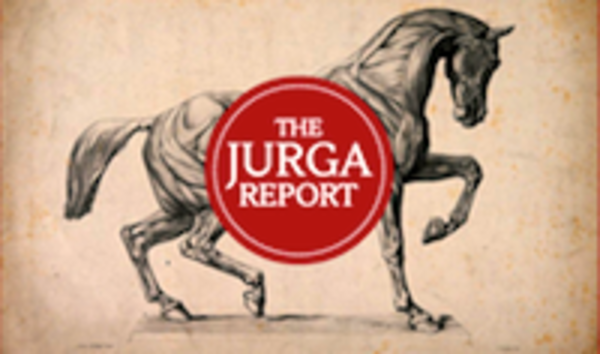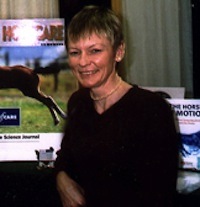Stephanie Valberg Will Be Next McPhail Dressage Chair at Michigan State Vet School
- March 10, 2017
- ⎯ Fran Jurga

It may be summer. The students may be off on vacations or internships. But at universities across the nation, the wheels are turning and changes are coming for the academic year ahead. One of the most prestigious endowed chairs in American equine science and veterinary medicine is the Mary Anne Phail Dressage Chair in Equine Sports Medicine at Michigan State’s vet school.
The McPhail Chair was established in 1997 to advance scientific investigation to benefit the sport of dressage by Mary Anne and Walter McPhail. The McPhail Equine Performance Center opened in 2000.

The Chair has been held since its endowment by Hilary M. Clayton, BVMS, PhD, DACVSMR. Dr. Clayton, who retired last year, now adds “emerita” to her title, as Michigan State announced the long-awaited name of her successor in this press release yesterday. Congratulations to Dr. Valberg, whose research has often been featured in The Jurga Report.
The following is an official news release from Michigan State University, with links added by The Jurga Report.
The Michigan State University College of Veterinary Medicine is pleased to announce that Dr. Stephanie Valberg has been named the Mary Anne McPhail Dressage Chair in Equine Sports Medicine in the Department of Large Animal Clinical Sciences. Valberg will join the College on November 1, 2015.
“Dr. Valberg is an international leader in understanding and managing equine neuromuscular disorders,” said Dan Grooms, chairperson of the Department of Large Animal Clinical Sciences. “Her experience in establishing collaborative relationships with specialists across the health sciences will play an important role in driving the research, teaching, and clinical missions of the Department and the College.”
The overarching goal of Valberg’s research is to define the basis for neuromuscular disorders in horses, develop accurate, minimally invasive diagnostic tests, and optimal methods for preventing or managing these diseases.

Valberg’s work in equine muscle disease has transformed equine clinical practice. Her research has led to the discovery of previously unknown muscle disorders, identification of their genetic basis, and development of nutritional strategies to minimize muscle pain. She also developed the first feed for horses used to treat “tying up,” or exertional rhabdomyolysis, which refers to muscle stiffness and pain after exercise. She also was a member of the team that sequenced the equine genome.
Valberg’s studies have included collaborations with epidemiologists, nutritionists, geneticists, neurologists, endocrinologists, biochemists, and physiologists.
“As a clinician scientist, one of the most important parts of my research is collaboration,” said Valberg. “The breadth of expertise in the health sciences at MSU will be important to my work—I don’t always know who I’m going to collaborate with until we start to get a research problem.”
Valberg comes to MSU from the University of Minnesota College of Veterinary Medicine. As a professor in the Department of Clinical and Population Sciences, she established the Neuromuscular Diagnostic Laboratory and directed the University of Minnesota Equine Center from 2003 to 2013.
The recipient of numerous honors, Valberg most recently was awarded the 2014 Richard Hartley Clinical Award from the British Equine Veterinary Association for her research linking seasonal pasture myopathy to box elder tree seeds. In 2013, she was selected to deliver the annual American Association of Equine Practitioners Milne Lecture, which recognizes a lifetime of service with the potential to change the paradigms by which veterinarians and researchers understand the recipient’s particular area of expertise. She was the first woman selected for the honor.
In 2012, Valberg became the first woman to be inducted into the Equine Research Hall of Fame. She has twice received the Pfizer Research Excellence Award, and in 1998 received the EquiSci International Award, an honor presented every four years to the individual whose work most significantly impacts equine exercise physiology research.
Valberg, who holds four patents, has authored or coauthored more than 140 peer-reviewed publications and 28 book chapters, as well as almost 100 articles in publications for the general public. She is a frequent speaker at national and international veterinary, nutrition, and genetic conferences.
Valberg has mentored more than 60 graduate students, interns, residents, and post-doctoral students and is a recipient of numerous awards for teaching and mentorship.
Valberg received her DVM from the University of Guelph Ontario Veterinary College and her PhD in equine exercise physiology from the Swedish University of Agricultural Sciences. She completed a residency in internal medicine at the University of California, Davis. She is board certified in large animal internal medicine and veterinary sports medicine and rehabilitation.
Her mentorship and work has been supported by the National Institutes of Health, the US Department of Agriculture, and industry partners and foundations.
Valberg is also an active horsewoman and is currently training Cajun, a 7-year-old Warmblood for three-day eventing, a triathlon competition of dressage, cross-country, and show jumping.
(end of news release)





